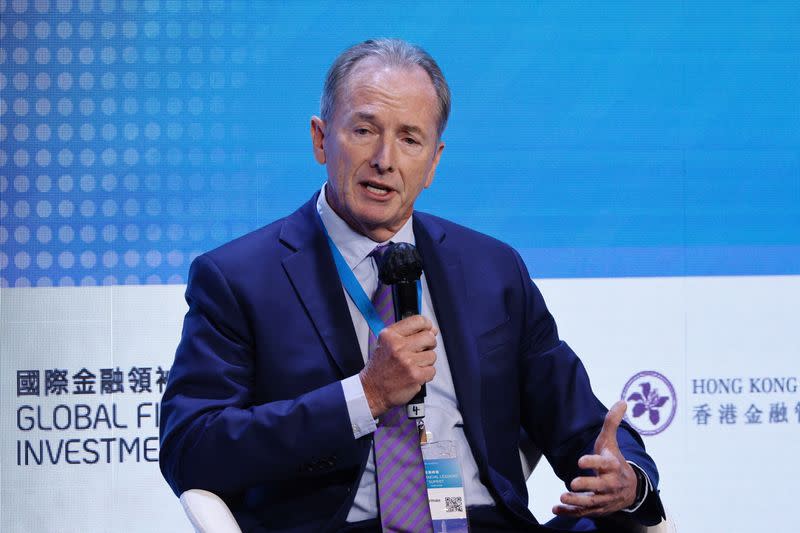Morgan Stanley's Aussie CEO Gorman transformed bank, deal by deal

By Lananh Nguyen
NEW YORK (Reuters) - When James Gorman made one of the biggest announcements of his career on Friday -- that he would be stepping down as Morgan Stanley CEO within a year -- he still managed to crack a joke.
"An issue of paramount importance to shareholders, employees and clients is, of course, succession -- and no, I'm not just talking about the TV series," Gorman told shareholders at the company's virtual annual meeting.
"And I definitely have no plans to go out like Logan Roy," he said, referring to the lead character in the HBO television show about the family of a media tycoon. In the show, Roy dies as CEO of the company, without having chosen a successor.
Gorman, 64, has led the Wall Street investment bank since 2010 and transformed it through a series of major deals. Under his leadership, Morgan Stanley became a wealth management powerhouse that aims to manage $10 trillion in assets.
Morgan Stanley bought money manager Eaton Vance, online broker E*Trade, and stock-plan manager Solium Capital under Gorman's leadership. He was also the key architect behind Morgan Stanley's purchase of Smith Barney, a brokerage and investment adviser, in 2009.
The acquisitions have made Morgan Stanley's U.S. wealth business an "asset gathering monster," and a "killer machine," he said on an earnings conference call last month. The firm's emphasis on serving wealthy clients decreased its reliance on more volatile businesses like investment banking and trading.
Known for his sharp analytical mind and blunt communication, Gorman reviews the bank's daily profit-and-loss accounts and writes down key numbers every night before he goes to bed, he told The Australian Financial Review last year.
"LONG JOURNEY"
The executive, a music fan also known for his dry sense of humor, grew up in Australia, one of 10 children. He earned bachelor's and law degrees from the University of Melbourne and an M.B.A. from Columbia University. He eventually became a U.S. citizen.
"I am also an immigrant, coming from Australia, and let me tell you, it is a long journey from Melbourne to New York, and I am very proud that I made it and I am now a citizen of this great country," Gorman told the House Financial Services Committee in 2021.
He started his career as an attorney before joining McKinsey & Co and rising to senior partner.
Gorman was then recruited on a handshake to Merrill Lynch by its former CEO David Komansky, Gorman told The New York Times in an obituary for Komansky, who died in 2021. Gorman went on to hold a series of executive positions at Merrill.
He joined Morgan Stanley in February 2006 and was named co-president the following year. As the 2008 financial crisis unfolded, threatening to topple some of Wall Street's biggest firms, Gorman had a front-row seat alongside then-CEO John Mack.
Gorman was a "strikingly calm, stalwart presence" focused on solving problems during the turmoil, Mack wrote in a memoir published last year.
Mack recounted an episode during which he negotiated an 11th-hour rescue deal from Japanese investors that meant hanging up on phone calls from the nation's top finance officials at the time, Treasury Secretary Henry Paulson, Federal Reserve Chairman Ben Bernanke and New York Fed President Tim Geithner.
"John, I learnt more in these 10 minutes than in any 12 month period of my career," Gorman wrote in a handwritten note to Mack, which is framed in Mack's office. "It is a story I will never stop telling."
Gorman was named CEO in January 2010 at the same time as his counterpart Brian Moynihan at Bank of America Corp.. Both executives, along with JPMorgan Chase & Co. Jamie Dimon, have steered their respective firms in the aftermath of the financial crisis.
Morgan Stanley's board has chosen three candidates who could take the helm, and Gorman will become executive chairman for a period when the new CEO takes over, he said, without naming his potential successors.
Morgan Stanley co-presidents Ted Pick and Andy Saperstein, and head of investment management Dan Simkowitz, are widely seen as contenders for the top job.
"When I do step down as CEO, it is the board's and my expectation that I will assume the role of executive chairman for a period of time," Gorman told shareholders.
"This structure will ensure the continued stability of Morgan Stanley, while at the same time positioning it for a decade of exciting growth under new leadership."
(Reporting by Lananh Nguyen; Editing by Anna Driver)

 Yahoo Finance
Yahoo Finance 